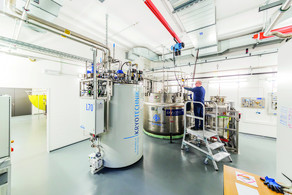Thesis defense of Florian Otte
- Defense
Resonant and non-resonant X-ray emission studies on cobalt bis(o-dioxolene) valence tautomers
The study and design of novel molecular materials, miniaturized molecular switches and sensors, is propelled by the investigation of electronically-labile systems. This property enables molecules to interconvert between distinct (meta-)stable electronic states. A prominent group of bistable molecular systems is represented by cobalt-based valence tautomer transition-metal complexes, which can be switched between tautomeric forms by external stimuli such as temperature, pressure, or irradiation by light. This transition is characterized by a combined metal-ligand charge-transfer and spin-crossover. The driving force behind valence tautomerism (VT) is the presence of redox-active benzoquinone-ligands, which enable the oxidation and reduction of the central cobalt ion between Co2+ to Co3+. These systems present scientific value not only due to their electronically-labile behavior and their potential application for the development of molecular storage or sensor units but also as model systems for larger, more complicated complexes. Valence tautomers are investigated since the late 1970s. Despite this, the amount of available element-specific and spin-sensitive Xray spectroscopic data is very limited. In this thesis, systematic studies on three cobalt valence tautomers were conducted to explore resonant- and non-resonant X-ray emission spectra for the presence of signatures of the VT process. Based on these spectra, time-resolved ultrafast investigation on a cobalt valence tautomer has been conducted by means of ultras-short highly-brilliant X-ray pulses, as they are produced by the European X-ray free-electron laser in Hamburg at the Femtoseconds X-ray Experiments (FXE) instrument. The obtained X-ray emission results indicate subtle differences between the spectral signatures of the individual valence tautomers, which are enhanced by the application of resonant X-ray emission methods. Time-resolved experiments on a valence tautomer indicate the presence of two ultra-short (sub 1 picosecond) dynamic processes. The interpretation and correlation with a photocycle for complexes exhibiting VT requires further investigation.










